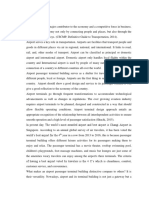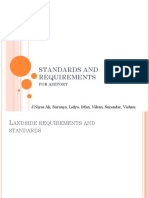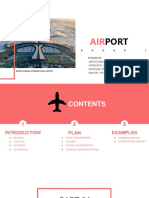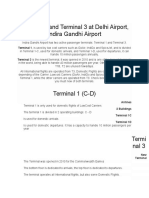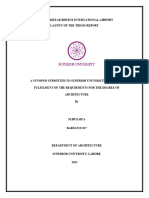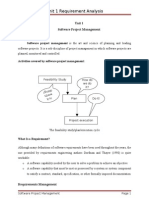International Airport
International Airport
Uploaded by
Kate CordialCopyright:
Available Formats
International Airport
International Airport
Uploaded by
Kate CordialCopyright
Available Formats
Share this document
Did you find this document useful?
Is this content inappropriate?
Copyright:
Available Formats
International Airport
International Airport
Uploaded by
Kate CordialCopyright:
Available Formats
CHAPTER I
THE PROBLEM
INTRODUCTION
An airport is an aerodrome with extended facilities, mostly for commercial air
transport. Airports often have facilities to store and maintain aircraft, and a control tower.
An airport consists of a landing area, which comprises an aerially accessible open space
including at least one operationally active surface such as a runway for a plane to take off
or a helipad, and often includes adjacent utility buildings such as control
towers, hangars and terminals. Larger airports may have fixed-base operator
services, airport aprons, taxiway bridges, air traffic control centres, passenger facilities
such as restaurants and lounges, and emergency services.
An airport with a helipad, or several, but no runways is called a heliport. An
airport for use by seaplanes and amphibious aircraft is called a seaplane base. Such a base
typically includes a stretch of open water for takeoffs and landings, and seaplane docks
for tying-up.
An airport is a gateway to a city. For a city to attract and retain corporations with
national and global ties – as well as talented people to work for them – efficient,
functional airports that are easily reached will be increasingly important. A city’s airport
is a first impression and a last impression. It facilitates face-to-face communication,
A PROPOSED INTERNATIONAL AIRPORT 1
strikingly important to generating innovation. The importance of airports as global
business hubs is now being recognized globally. In some parts of the world, entire cities
or at least fully functioning suburbs are being built around airports in a phenomenon
known as the aerotropolis. Airports are the building of the future for their deep
importance to the society and the advancement in technology make them to be more
modern and dynamic than any other public building. Airports are among the most
significant public building types of the modern age. Airports play an important role in
shaping the global image of their surrounding environment. They are also major
economic centers and generators of wealth. As facilitators of trade and tourism, airports
are key to economic development and to connecting people.
An international airport has additional facilities for customs and passport
control as well as incorporating all of the aforementioned elements. Such airports rank
among the most complex and largest of all built typologies with 15 of the top 50
buildings by floor area being airport terminals. An international airport is
an airport with customs and border control facilities enabling passengers to travel
between countries. International airports are typically larger than domestic airports and
often feature longer runways and facilities to accommodate the heavier aircraft
commonly used for international and intercontinental travel. International airports often
also host domestic flights. Some, such as Heathrow Airport in the United Kingdom, are
very large. Others, such as Fa'a'ā International Airport in Tahiti, are quite small.
Buildings, operations and management have become increasingly sophisticated since the
mid 20th century, when international airports began to provide infrastructure for
A PROPOSED INTERNATIONAL AIRPORT 2
international civilian flights. Detailed technical standards have been developed to ensure
safety and common coding systems implemented to provide global consistency. The
physical structures that serve millions of individual passengers and flights are among the
most complex and interconnected in the world. By the second decade of the 21st century,
there were over 1,200 international airports and almost two billion international
passengers along with 50 million metric tonnes of cargo were passing through them
annually.
The Philippines is a country composed of over 7,000 islands, and thus the
improvement of air transport is considered to be a critical factor for the country’s
development. Assuring the efficiency of transport services to meet the needs of dynamic
market demand was one of the major objectives of in the Philippines’ transport sector, as
outlined in the Medium-Term Development Plan 1993-98. The Government undertook a
strategy of continuously upgrading transport facilities and service standards to ensure that
qualitative and quantitative improvements kept pace with traffic growth. Thus, the
upgrading of Ninoy Aquino International Airport (NAIA) was given priority through the
construction of Terminal 2. The importance of air transport in the Philippines continues
to grow. The Medium Term Development Plan 1999-2004 states that, “consistent with
the globalization of the economy, the development of more international gateways to
cater to different regional markets and the upgrading of domestic airports to international
standards will be pursued to attract domestic linkages with foreign carriers.” In this light,
the current project has maintained its relevance with the Government’s development
policy to the present.
A PROPOSED INTERNATIONAL AIRPORT 3
STATEMENT OF THE PROBLEM
Air transportation in the Philippines is imperative for the country’s socio-
economic development and for its interaction with the international community. Ninoy
Aquino International Airport (NAIA), located in the capital of the country, handles
almost 100% of the country’s international flights and more than 60% of its domestic
flights. The number of passengers passing through NAIA was already 5.2 million per
year for international and 3 million for domestic flights in 1992. Although the volume
was still growing rapidly, passenger traffic had already exceeded the respective capacities
of the airport’s terminals, which stood at 4.3 million for international flights and 2 million
for domestic flights. As a result, both international and domestic terminals were heavily
congested with passengers. In order to cope with the future demand for air transport and
to ensure smoothness, comfort, and security for the passengers, the construction of a new
terminal became a priority project for the national air transport sector program of the
Philippines. City Airport is not enough to accommodate more passengers and other types
of aircraft, and it is, somehow, the technology has been left out of time. The problems
that is addressed by the researchers are the following:
OBJECTIVES OF THE STUDY
A PROPOSED INTERNATIONAL AIRPORT 4
The scope of this proposal is to design an iconic image to the Province of
Camarines Sur recognition in aviation. This airport offers an international feels to
passengers.
The principal objective of the study is to provide the best solutions to the
problems addressed by the researchers. Specifically, to provide a new international
airport that can accommodate more types of an aircraft, improve and propose a facilities
which have been omitted, and to provide aesthetically and functional airport terminal that
can please tourist and the comfort of the everyday passengers. Thus, the study will aim to
improve the overall image of the Philippines Air Transport System and also the
Camarines Sur itself to ameliorate tourism.
SCOPE AND DELIMITATION
Scope
The scope of this study deals with evaluation, architectural, planning and concept
of the New International Airport. The factors, laws, policies, and guidelines affecting the
present condition of the site proposal and determining the physical development needed
to provide and support of the said study. This involve the connection of pertinent data
statistical information to support the Design Stage of the study.
Delimitation
The proposed solution is the delimited on Architectural Design matters. This will
not include the areas that need an extensive specialization, such as structural and
electrical computations. The detailed budget and estimate of construction cost.
Construction time table and the likes will also not be included in the proposal.
A PROPOSED INTERNATIONAL AIRPORT 5
DEFINITION OF TERMS
Accident
An occurrence associated with the operation of an aircraft which, in the
case of a manned aircraft, takes place between the time any person boards the
aircraft with the intention of flight until such time as all such persons have
disembarked, or in the case of an unmanned aircraft, takes place between the time
the aircraft is ready to move with the purpose of flight until such time as it comes
to rest at the end of the flight and the primary propulsion system is shut down, in
which:
(a) a person is fatally or seriously injured as a result of:
- being in the aircraft, or
- direct contact with any part of the aircraft, including parts which have
become detached from the aircraft, or
- direct exposure to jet blast, except when the injuries are from natural
causes, self-inflicted or inflicted by other persons, or when the injuries are
to stowaways hiding outside the areas normally available to the passengers
and crew; or
(b) the aircraft sustains damage or structural failure which:
A PROPOSED INTERNATIONAL AIRPORT 6
- adversely affects the structural strength, performance or flight
characteristics of the aircraft, and
- would normally require major repair or replacement of the affected
component, except for engine failure or damage, when the damage is
limited to a single engine, (including its cowlings or accessories), to
propellers, wing tips, antennas, probes, vanes, tires, brakes, wheels,
fairings, panels, landing gear doors, windscreens, the aircraft skin (such as
small dents or puncture holes), or for minor damages to main rotor blades,
tail rotor blades, landing gear, and those resulting from hail or bird strike
(including holes in
the radome); or
Accuracy
A degree of conformance between the estimated or measured value and
the true value. Aerodrome. A defined area on land or water (including any
buildings, installations, and equipment) intended to be used either wholly or in
part for the arrival, departure and surface movement of aircraft. Aerodrome
mapping data (AMD). Data collected for the purpose of compiling aerodrome
mapping information for aeronautical uses Note: - Aerodrome mapping data are
collected for purposes that include the improvement of the user’s situational
awareness, surface navigation operations, training, charting and planning.
Aerodrome mapping database (AMDB)
A collection of aerodrome mapping data organized and arranged as a
structured data set.
A PROPOSED INTERNATIONAL AIRPORT 7
Aerodrome reference point
The designated geographical location of an aerodrome. Aircraft parking
position. A designated area on an apron intended to be used for parking an
aircraft, also known as an aircraft stand.
Airside
The movement area of an aerodrome, adjacent terrain and buildings or
portions thereof, to which access is controlled.
Apron
A defined area on a land aerodrome intended to accommodate aircraft for
the purposes of loading or unloading passengers, mail or cargo, fueling, parking,
or
maintenance.
Clearway
A defined rectangular area on the ground or water under the control of an
appropriate authority; at the end of the take-off run available on the ground or
water under the control of the aerodrome operator, selected or prepared as a
suitable area over which an aeroplane may make a portion of its initial climb to a
specified height.
Critical aeroplane
The aeroplane or aeroplanes identified from among the aeroplanes the
aerodrome is intended to serve as having the most demanding operational
requirements with respect to the determination of movement area dimensions,
A PROPOSED INTERNATIONAL AIRPORT 8
pavement bearing strength and other physical characteristics in the design of
aerodromes.
Critical obstacle
The obstacle within the take-off climb area and/or the approach area,
which subtends the greatest vertical angle when measured from the inner edge of
the take
off climb surface and/or the approach surface.
Cross-wind component
The surface wind component at right angles to the runway centerline.
Elevation
The vertical distance of a point or a level, on or affixed to the surface of
the earth, measured from the mean sea level.
Fixed light
A light having constant luminous intensity when observed from a fixed
point.
Holding bay
A defined area where aircraft can be held, or bypassed, to facilitate
efficient
surface movement of aircraft.
Hot spot
A location on an aerodrome movement area with a history or potential risk
of collision or runway incursion, and where heightened attention by pilots/drivers
is necessary.
A PROPOSED INTERNATIONAL AIRPORT 9
Incident
An occurrence, other than an accident, associated with the operation of an
aircraft which affects or could affect the safety of operation.
Note:
- The types of incidents which are of main interest to the International
Civil
Aviation Organization for accident prevention studies are listed.
Landing area
That part of a movement area intended for the landing or take-off of
aircraft.
Landing direction indicator
A device to indicate visually the direction currently designated for landing
and for take-off.
Light failure
A light shall be deemed to be unserviceable when the main beam average
intensity is less than 50% of the value specified in the appropriate figure showing
the isocandela diagram. For light units where the designed main beam average
intensity is above the value shown in the isocandela diagram, the 50% value shall
be related to that design value. (When assessing the main beam, specified angles
of beam elevation, toe-in and beam spread shall be taken into consideration).
Lighting system reliability
The probability that the complete installation operates within the specified
tolerances and that the system is operationally usable.
A PROPOSED INTERNATIONAL AIRPORT 10
Maneuvering area
That part of the aerodrome to be used for the take-off, landing and taxiing
of aircraft, excluding aprons.
Marker
An object displayed above ground level in order to indicate an obstacle or
delineate a boundary.
Marking
A symbol or group of symbols displayed on the surface of the movement
area in order to convey aeronautical information.
Mass
The terms mass and weight used in aerodrome standards have the same
meaning.
Movement
Either a take-off or a landing by an aircraft.
Movement area
That part of the aerodrome to be used for the take-off, landing and taxiing
of aircraft, consisting of the maneuvering area and the apron(s).
Near parallel runways
Non-intersecting runways whose extended centerlines have an angle of
convergence/divergence of 15° or less.
Obstacle
All fixed (whether temporary or permanent) and mobile objects, or parts
thereof, that:
A PROPOSED INTERNATIONAL AIRPORT 11
(a) are located on an area intended for the surface movement of aircraft; or
(b) extend above a defined surface intended to protect aircraft in flight; or
(c) stand outside those defined surfaces and have been assessed as being a
hazard to air navigation.
Road
An established surface route on the movement area meant for the
exclusive use of vehicles.
Runway
A defined rectangular area on a land aerodrome prepared for the landing
and take-off of aircraft.
Runway end safety area (RESA)
An area symmetrical about the extended runway centerline and adjacent to
the end of the runway strip primarily intended to reduce the risk of damage to an
aeroplane undershooting or overrunning the runway.
Runway guard light
A light system intended to caution pilots or vehicle drivers that they are
about to enter an active runway. Runway strip. A defined area including the
runway, and stopway if provided, intended:
(a) to reduce the risk of damage to aircraft running off a runway; and
(b) to protect aircraft flying over it during take-off or landing operations.
Runway Turn Pad
A defined area on a land aerodrome adjacent to a runway intended for the
purpose of completing a 180-degree turn on a runway.
A PROPOSED INTERNATIONAL AIRPORT 12
Runway visual range (RVR)
The range over which the pilot of an aircraft on the centerline of the
runway can see the runway surface markings or the lights delineating the runway
or identifying its centerline.
Safety programme
An integrated set of regulations and activities aimed at improving safety.
Safety management system (SMS)
A systematic approach to managing safety including the necessary
organizational structure, accountabilities, policies and procedures.
Signal area
An area on an aerodrome used for the display of ground signals.
Station declination
An alignment variation between the zero degree radial of a VOR and
true north, determined at the time the VOR station is calibrated.
Stopway
A defined rectangular area on the ground at the end of the take-off run
available prepared as a suitable area in which an aircraft can be stopped in the
case of an abandoned take-off.
Switch-over time (light)
The time required for the actual intensity of a light measured in a given
direction to fall from 50% and recover to 50% during a power supply changeover,
when the light is being operated at intensities of 25% or above.
Take-off runway
A PROPOSED INTERNATIONAL AIRPORT 13
A runway intended for take-off only.
Taxiway
A defined path on a land aerodrome established for the taxiing of aircraft
and intended to provide a link between one part of the aerodrome from another,
including:
(a) Aircraft stand (parking position) taxilane. A portion of an apron
designated as a taxiway and intended to provide access to aircraft parking
positions only.
(b) Apron taxiway. A portion of a taxiway system located on an apron and
intended to provide a through taxi route across the apron.
(c) Rapid exit taxiway. A taxiway connected to a runway at an acute angle
and designed to allow landing aeroplanes to turn off at higher speeds than
are achieved on other exit taxiways thereby minimizing runway
occupancy times.
Taxiway intersection
A junction of two or more taxiways.
Taxiway strip
An area including a taxiway intended to protect an aircraft operating on
the taxiway and to reduce the risk of damage to an aircraft accidentally running
off the taxiway.
Threshold
A PROPOSED INTERNATIONAL AIRPORT 14
The beginning of that portion of the runway usable for landing.
Touchdown zone. The portion of a runway, beyond the threshold, where it is
intended landing aeroplanes first contact the runway.
Visibility
The ability, as determined by atmospheric conditions and expressed in
units of distance, to see and identify prominent unlit objects by day and prominent
lit objects by night.
Visual meteorological conditions (VMC)
Meteorological conditions expressed in terms of visibility, distance from
cloud, and ceiling, equal or better than specified minima.
Weight
The terms weight and mass used in aerodrome standards have the same meaning.
CHAPTER II
RELATED LITERATURE AND STUDIES
RELATED LITERATURE
Ninoy Aquino International Airport
The Ninoy Aquino International Airport (Filipino: Paliparang
Pandaigdig ng Ninoy Aquino) or NAIA (/ˈnaɪə/), formerly known and still
A PROPOSED INTERNATIONAL AIRPORT 15
commonly referred to as Manila International
Airport (IATA: MNL, ICAO: RPLL) as well as its codename Nichols
Field(Nichols), is the airport serving Manila and its surrounding metropolitan
area. Located along the border between the cities of Pasayand Parañaque, about 7
kilometres (4.3 mi) south of Manila proper and southwest of Makati, NAIA is the
main international gateway for travelers to the Philippines and serves as a hub
for AirAsia Philippines, Cebgo, Cebu Pacific, PAL Express, and Philippine
Airlines. It is managed by the Manila International Airport Authority (MIAA), a
branch of the Department of Transportation (DOTr).
Officially, NAIA is the only airport serving the Manila area. However, in
practice, both NAIA and Clark International Airport, located in the Clark Freeport
Zone in Pampanga serve the Manila area, with Clark catering mostly to low-cost
carriers because of its lower landing fees compared to those charged at NAIA. In
the recent past there have been calls for Clark to replace NAIA eventually as the
primary airport of the Philippines.[4] The airport is named after the late
Senator Benigno "Ninoy" Aquino, Jr., who was assassinated at the airport in
1983. In 2017, all terminals at NAIA handled a record-breaking annual passenger
traffic of 42,022,484, an increase of 5.96% from the previous year.
Francisco Bangoy International Airport
A PROPOSED INTERNATIONAL AIRPORT 16
Francisco Bangoy International Airport (Cebuano: Tugpahanang
Pangkalibutan sa Francisco Bangoy, Filipino: Paliparang Pandaigdig ng
Francisco Bangoy), also known and still commonly referred to as Davao
International Airport (IATA: DVO, ICAO: RPMD), is the main airport
serving Davao City and Davao Region in the Philippines. It is the busiest airport
on the island of Mindanaoand the third busiest in the Philippines. The airport has
a single 3,000-meter precision runway.
A new terminal replaces the previous airport terminals, which lie just
across it, in handling both domestic and international flights operating to and from
Davao. The modern facility is designed to handle approximately 2 million
passengers annually and 84,600 metric tons of cargo annually. The added capacity
is also complemented by the latest navigational, security, and baggage handling
equipment.
The modernization and upgrading of the airport facilities aims to cement
Davao as a hub for tourism and foreign investment in the region. Development
was funded by a forty million-dollar loan from the Asian Development Bank, co-
financed by the European Investment Bank for twenty-five million ECUs, and
A PROPOSED INTERNATIONAL AIRPORT 17
through budgetary allocations from the government. The total cost of the project
amounted to $128 million.
After almost a decade, the new terminal was finally inaugurated on
December 2, 2003. Initial construction began in 2000 while plans for construction
were announced in 1992.
On November 12, 2007, Cebu Pacific announced this airport as its
third hub. Philippine Airlines, the country's flag carrier, announced this airport as
its third hub on March 26, 2018.
Puerto Princesa International Airport
Puerto Princesa International Airport (Filipino: Paliparang
Pandaigdig ng Puerto Princesa; Hiligaynon: Pangkalibutan nga Hulugpaan sang
A PROPOSED INTERNATIONAL AIRPORT 18
Puerto Princesa) (IATA: PPS, ICAO: RPVP) is an airport serving the general
area of Puerto Princesa, located in the province of Palawan in the Philippines. It is
classified as an international airport by the Civil Aviation Authority of the
Philippines.
The airport is the main gateway to the Puerto Princesa Underground River,
a UNESCO World Heritage Site and one of the New 7 Wonders of Nature.
Subic Bay International Airport
Subic Bay International Airport (Filipino: Paliparang Pandaigdig ng
Look ng Subic) or SBIA (IATA: SFS, ICAO: RPLB) serves as a secondary
airport and a main diversion airport of the Ninoy Aquino International Airport. It
is also the airport serving the immediate area of the Subic Bay Freeport Zone, the
municipality of Morong, Bataan and the general area of Olongapo in
the Philippines. This airport was previously Naval Air Station Cubi Point of
the United States Navy.
General Santos International Airport
A PROPOSED INTERNATIONAL AIRPORT 19
General Santos International Airport, (stylized as General Santos City
Airport)(Cebuano: Tugpahanang Pangkalibutanon sa Heneral
Santos, Hiligaynon: Pangkalibutan nga Hulugpaan sang Heneral Santos),
(IATA: GES, ICAO: RPMR) is an alternate international airport located in the
city of General Santos, Philippines serving the greater area
of SOCCSKSARGEN (Region XII). Situated in Prk New Hondagua, Uhaw,
Barangay Fatima, the airport is the largest airport in the island of Mindanao[2] and
is officially classified an International Airport by the Civil Aviation Authority of
the Philippines (CAAP), a government bureau which is responsible in the
management and operations of General Santos International Airport and all other
airports in the country except regular international airports.
Inaugurated on July 6, 1996 in time to serve the influx of visitors, athletes
and participants coming in from different parts of the country who were taking
part in the 42nd annual Palarong Pambansa (National Games) that was held
in South Cotabato, Sarangani and General Santos (SOCSARGEN) area at that
time. Since then, the new airport immediately replaced the old and smaller
Buayan Airport in Barangay Buayan, which is now converted into an air station
A PROPOSED INTERNATIONAL AIRPORT 20
for the use of The Philippine Air Force and renamed it "Rajah Buayan Air Base".
Though new, wider and much modern, General Santos International Airport
nevertheless retained its old IATA airport code(GES) from the old Buayan
Airport.
Iloilo International Airport
Iloilo International Airport (Hiligaynon: Pangkalibutan nga Hulugpaan
sang Iloilo, Filipino: Paliparang Pandaigdig ng Iloilo)
(IATA: ILO, ICAO: RPVI), also known as Iloilo Airport, and as Cabatuan
Airport, after the municipality of Cabatuan, Iloilo where this airport is
located, and sometimes erroneously as Santa Barbara Airport for the nearby
municipality of Santa Barbara, Iloilo, is the airport serving the province
of Iloilo in the Philippines, including its capital city, Iloilo City, the regional
center of the Western Visayasregion. It opened its doors to commercial traffic on
June 14, 2007 after a decade of planning and construction, replacing Mandurriao
Airport in Mandurriao, Iloilo City which had been in service for over seventy
years. As a result, the new airport inherited its IATA and ICAO airport codes, as
A PROPOSED INTERNATIONAL AIRPORT 21
well as its position as the fourth-busiest airport in the Philippines, from its
predecessor. It is the first airport in both Western Visayas and the island
of Panay to be built to international standards, and it is also considered to be the
primary gateway into the region. It is classified as an international airport by
the Civil Aviation Authority of the Philippines.
The airport is located in Cabatuan, Iloilo, 24 kilometers (15 mi) northwest
of Iloilo City on a 188-hectare (460-acre) site spread across Barangays Tabucan,
Tiring, Gaub, Duyan-Duyan and Manguna. The airport complex consists of a
single runway, various administrative and maintenance buildings, waste-sorting
and water-treatment facilities, a power-generating station, a cargo terminal, and a
main passenger terminal. Its location on the Tomas Confesor Highway, a major
highway transversing the island, makes the airport accessible from all parts of
Iloilo and Panay by road, while its proximity to the currently defunct Panay
Railways network could potentially link the airport to the rest of Panay by rail.
Built in slightly over 30 months, Iloilo International Airport is one of the
largest airports to be constructed in the Philippines. At its inauguration,
President Gloria Macapagal-Arroyo remarked that the airport was the most
beautiful and modern in the country and called it a symbol of both political will
and economic maturity.
Kalibo International Airport
A PROPOSED INTERNATIONAL AIRPORT 22
Kalibo International Airport (Aklanon: Pangkalibutan nga Paeoparan
it Kalibo, Hiligaynon: Pangkalibutan nga Hulugpaan sang
Kalibo, Filipino: Paliparang Pandaigdig ng Kalibo)
(IATA: KLO, ICAO: RPVK) is an international airport that serves the general
area of Kalibo, the capital of the province of Aklan in the Philippines, and is one
of two airports serving Boracay, the other being Godofredo P. Ramos Airport also
known as Caticlan Airport in the town of Malay. It is the fastest growing airport
in the Philippines in terms of passenger traffic with more than 50% growth in
2010, and 2nd fastest for seats offered for June 2014 over the corresponding
month of the
previous year (20%). The airport is classified as an international airport by
the Civil Aviation Authority of the Philippines, a body of the Department of
Transportation and Communications responsible for the operations of all airports
in the Philippines except major international airports.
The airport is situated 2 kilometres (1.2 mi) east of the main area of
Kalibo and 68 kilometres (42 mi) from Caticlan port in Malay. Kalibo
International Airport services international destinations such as Taipei, Seoul–
A PROPOSED INTERNATIONAL AIRPORT 23
Incheon, Busan, Shanghai, Chengdu, Hong Kong and Singapore. It offers more
international destinations than domestic destinations.
Laoag International Airport
Laoag International Airport (Ilokano: Sangalubongan a Pagpatayaban
ti Laoag, Filipino: Paliparang Pandaigdig ng Laoag)
(IATA: LAO, ICAO: RPLI) is the main airport serving the general area
of Laoag, the capital city of the province of Ilocos Norte in the Philippines. It is
the only airport in Ilocos Norte and is the northernmost international airport in the
Philippines by geographical location. The airport is a popular charter destination
for tourists from China.
It has one 2,420-meter runway and is designated as a secondary/alternate
international airport by the Civil Aviation Authority of the Philippines, a body of
the Department of Transportation that is responsible for the operations of not only
this airport but also of all other airports in the Philippines except the major
international airports.
Zamboanga International Airport
A PROPOSED INTERNATIONAL AIRPORT 24
Zamboanga International Airport (Spanish, Chavacano: Aeropuerto
Internacional de Zamboanga; Filipino: Paliparang Pandaigdig ng Zamboanga;
(IATA: ZAM, ICAO: RPMZ) is the main airport serving Zamboanga City in
the Philippines. The airport is Mindanao's third-busiest airport after Francisco
Bangoy International Airport in Davao City and Laguindingan Airport in Cagayan
de Oro City. The airport covers a total land area of 270 hectares.
The airport is officially classified as an international airport by the Civil
Aviation Authority of the Philippines, despite only offering scheduled domestic
passenger services. This is the same agency that runs not only Zamboanga
International Airport, but all other airports in the Philippines except the major
international airports.
Mactan–Cebu International Airport
A PROPOSED INTERNATIONAL AIRPORT 25
Mactan–Cebu International Airport (Cebuano: Tugpahanang
Pangkalibutan sa Mactan–Sugbo, Filipino: Paliparang Pandaigdig ng Mactan–
Cebu) (IATA: CEB, ICAO: RPVM) located in Central Visayas region, is the
second busiest international airport in the Philippines. It is located in Lapu-Lapu
City on Mactan Island, a part of Metro Cebu. The airport is managed by the
Mactan–Cebu International Airport Authority. It covers an area of 797 hectares
(1,970 acres).
It has a single 3,300-meter (10,800 ft) runway that was built by the United
States in 1956 as an emergency airport for Strategic Air Command bombers and
was known as the Mactan Air Base. The runway is complemented by a full-length
taxiway that it shares with the current Mactan Air Base of the Philippine Air
Force.
Mactan–Cebu International Airport was chosen as the most viable location
for the world's largest aircraft, the Antonov An-225 Mriya, to safely land when
considering the combination of onward land transportation, sea freight, and
airport capacity. The arrival of the aircraft in the airport marked the very first time
that the aircraft landed in the Philippines.
Clark International Airport
A PROPOSED INTERNATIONAL AIRPORT 26
Clark International Airport (IATA: CRK, ICAO: RPLC)
(Kapampangan: Pangyatung Sulapawan ning Clark, Filipino: Paliparang
Pandaigdig ng Clark), is an airport that is an international gateway to
the Philippines within Clark Freeport Zone in Mabalacat City, located
43.2 NM (80.0 km; 49.7 mi) northwest of Manila. The airport is located in the
province of Pampanga and is accessible through the Subic–Clark–Tarlac
Expressway, which is connected to the North Luzon Expressway.
Clark serves the general vicinity of central and northern Luzon. The name
is derived from the former American Clark Air Force Basewhich was the largest
overseas base of the United States Air Force until it was closed in 1991 and
handed over to the Government of the Philippines.
The airport is managed and operated by Clark International Airport
Corporation (CIAC), a government-owned enterprise; and the southern part of the
facility is utilized by the Philippine Air Force as Clark Air Base.
Clark serves both international and domestic flights. A new passenger
terminal building is under construction and is expected to be finished in 2020.
Bicol International Airport
A PROPOSED INTERNATIONAL AIRPORT 27
Bicol International Airport (Filipino: Paliparang Pandaigdig ng
Bikol, Bikol: Pankinàban na Palayogan kan Bikol, Cebuano:Tugpahanang
Pangkalibutan ng Bikol) is an under-construction international airport that will
serve Legazpi, the capital city of Albay and the regional center of Bicol Region,
in the Philippines.
The airport is located in Daraga, an adjacent municipality of Legazpi. The
₱3.5 billion project is on a 200-hectare plateau 15 kilometers from Mayon
Volcano. Some sources name the airport Southern Luzon International
Airport (Filipino: Paliparang Pandaigdig ng Katimogang Luzon,
Cebuano:Tugpahanang Pangkalibutan ng Katimogang Luzon). It will replace the
old Legazpi Airport, which is only 2 to 3 kilometers from the volcano.
CHAPTER III
A PROPOSED INTERNATIONAL AIRPORT 28
RESEARCH DESIGN AND METHODOLOGY
This chapter discusses the procedure in acquiring data, instruments, materials,
research design methods that the proponents used in order to obtain sufficient data and
information for the Proposed International Airport and materials used to gather all the
necessary for the study in which are used as a reference for the data analysis.
Research Design
The research design used for the study were descriptive and analysis, during this
process some problems and factors were considered. Site inspection and survey, data
gathered were reviewed and analyzed in the succeeding chapter. Also, related literature
and studies were also used as a re basis in this study.
Data Gathering Procedure
Data gathering served as the foundation for the proposing solution for the
problems. Data were collected through the following:
1. Library Works
The researcher collected data through sources coming from related
published materials such as books, maps and existing plans of the public spaces
that will help for the development of the proposed project. Also, incudes
supplementary information related to the study through magazines, books and
other related studies in connection with the study.
A PROPOSED INTERNATIONAL AIRPORT 29
2. Ocular visit/ Site Inspection
Data from actual site inspection and documentation of the study area
which includes the present existing conditions of the public spaces, surrounding
buildings and actual road conditions were considers. It also includes the
investigation of the physical features, aspects of the site that determines the plans,
details and external factors.
3. Interview/Research
Gathering data and eliciting information, or consulting straight from a
person having a greater knowledge in regards with the study. With the use of
question and answer format and open-ended conversation where questions are
given spontaneously relative to the flow of the answer given by the responded.
Data Gathering Instrument
1. Questionnaires
The questionnaires given by the proponents to the respondents during oral
investigation process.
2. Checklist for Site Inventory
Examining the existing the site features and conditions, road accessibility
through documentation and picture taking were considers as a part of the actual
site inspection
A PROPOSED INTERNATIONAL AIRPORT 30
You might also like
- Us Non VBVDocument19 pagesUs Non VBVmarco.20No ratings yet
- New Sialkot International AirportDocument7 pagesNew Sialkot International Airportm.suleman Khushi100% (2)
- A. Project Brief & Design RequirementsDocument35 pagesA. Project Brief & Design Requirementskk kumarNo ratings yet
- Airport Space Requirements FinalDocument52 pagesAirport Space Requirements FinalKaye Monique100% (5)
- Thesis ChaptersDocument50 pagesThesis ChaptersVenc BoneteNo ratings yet
- Research Paper: International AirportDocument10 pagesResearch Paper: International AirportGladdelyn Piencenaves100% (1)
- Airport PlanningDocument24 pagesAirport PlanningArie WibowoNo ratings yet
- Clark International Airport Terminal 2Document8 pagesClark International Airport Terminal 2Rey Leonard Amorato100% (1)
- Airport Basic ComponentsDocument5 pagesAirport Basic ComponentsCJ Laforteza100% (2)
- Standards and Requirements: For AirportDocument51 pagesStandards and Requirements: For AirporteshNo ratings yet
- Cargo Terminal Standards 121021Document16 pagesCargo Terminal Standards 121021suryakeshwar singhNo ratings yet
- A Presentation On Design of AirportDocument26 pagesA Presentation On Design of AirportOyelakin Gbolahan Pearl50% (4)
- Design and Development of Passenger Terminal Extension of Clark International AirportDocument183 pagesDesign and Development of Passenger Terminal Extension of Clark International AirportVincent BautistaNo ratings yet
- Planning and Design Fundamentals of AirportDocument17 pagesPlanning and Design Fundamentals of AirportFatima Ramilo Villanueva100% (1)
- Airport ResearchDocument17 pagesAirport ResearchCharineNo ratings yet
- AIRPORTDocument17 pagesAIRPORTCorrine Bonocan100% (1)
- A.) What Does International Airport Mean?: Domestic FlightsDocument13 pagesA.) What Does International Airport Mean?: Domestic FlightsAbygail MorenoNo ratings yet
- Airport Planning & Taxiway Design PDFDocument54 pagesAirport Planning & Taxiway Design PDFv.tamilarasi86% (7)
- Design 5 AirportDocument43 pagesDesign 5 AirportPaul Isaac Pareñas100% (2)
- The Airport DesignDocument7 pagesThe Airport DesignTj Prabu100% (1)
- AirportDocument8 pagesAirportShiela CedronNo ratings yet
- Airport Research FINALDocument87 pagesAirport Research FINALRegie Mae B. EslaisNo ratings yet
- Airport Space RequirementsDocument3 pagesAirport Space RequirementsRaphael AustriaNo ratings yet
- Airport Design PDFDocument83 pagesAirport Design PDFice100% (1)
- Airport DesignDocument29 pagesAirport DesignBenjamin Chua100% (2)
- Standards of Airport 1Document58 pagesStandards of Airport 1eshNo ratings yet
- Case Study Checklist For AirportDocument5 pagesCase Study Checklist For Airportcrustybubbles100% (1)
- Airport PlanningDocument29 pagesAirport PlanningMutiba Fatima100% (2)
- Airport Terminal Design: Rafiur RahmanDocument44 pagesAirport Terminal Design: Rafiur RahmanTaim Khan100% (2)
- Madrid AirportDocument33 pagesMadrid AirportAnnie Shamim100% (1)
- Airport DesignDocument83 pagesAirport DesignAly100% (4)
- Airport Planning and Design Unit 5Document22 pagesAirport Planning and Design Unit 5SreNo ratings yet
- AIRPORT DESIGN by WYC Architecture and DesignDocument21 pagesAIRPORT DESIGN by WYC Architecture and Designwrightwoman100% (1)
- Airports PDFDocument114 pagesAirports PDFJaelani Abdul K100% (1)
- Airport ParkingDocument31 pagesAirport Parkingsatishjgec2004No ratings yet
- Airport Terminal DesignDocument8 pagesAirport Terminal DesignDIBYENDU MONDALNo ratings yet
- Designing Airport Pax BldgsDocument27 pagesDesigning Airport Pax BldgssandhiyapbsmNo ratings yet
- International Airport Research PaperDocument130 pagesInternational Airport Research PaperAyrah Soguilon100% (3)
- Hong Kong International AirportDocument15 pagesHong Kong International AirportJacky WongNo ratings yet
- AC 150 5360 13A Airport Terminal Planning FAADocument100 pagesAC 150 5360 13A Airport Terminal Planning FAAorcun_ert100% (2)
- Changi International Airport Research PaperDocument3 pagesChangi International Airport Research PaperShineristy Eka IndriannisaNo ratings yet
- Airport ResearchDocument28 pagesAirport ResearchStephanie BacsalNo ratings yet
- Proposed International Airport Baby ThesisDocument73 pagesProposed International Airport Baby ThesisMeryl EscobarNo ratings yet
- Airport Thesis Mid TermDocument11 pagesAirport Thesis Mid TermHamza AfridiNo ratings yet
- Standards of Airport 01Document51 pagesStandards of Airport 01esh100% (1)
- Airport Case Studies Chapter III and IVDocument21 pagesAirport Case Studies Chapter III and IVRenzo LopezNo ratings yet
- Airport DesignDocument40 pagesAirport DesignSharath Kumar K100% (3)
- Research Paper For AirportDocument15 pagesResearch Paper For AirportNicole CustodioNo ratings yet
- Organization and Administration of An Airport - 2020Document23 pagesOrganization and Administration of An Airport - 2020Ruvinya HerathNo ratings yet
- 03 Airport Planning, and Site SelectionDocument28 pages03 Airport Planning, and Site SelectionjohnNo ratings yet
- Terminal Area and Airport LayoutDocument32 pagesTerminal Area and Airport LayoutHanamant HunashikattiNo ratings yet
- AirportDocument49 pagesAirportPaul Isaac PareñasNo ratings yet
- AVT 2217 Module 1 - Airport Design and OperationDocument15 pagesAVT 2217 Module 1 - Airport Design and OperationLeGrand BeltranNo ratings yet
- Terminal 1 and Terminal 3 at Delhi AirportDocument5 pagesTerminal 1 and Terminal 3 at Delhi AirportAnonymous QdmttSTiNo ratings yet
- Airport SynopsisDocument3 pagesAirport SynopsisAashir YaqubNo ratings yet
- Zoning: C-1: Tla Flar (Tla) (BHL) /ambf Tosl Isa + UsaDocument5 pagesZoning: C-1: Tla Flar (Tla) (BHL) /ambf Tosl Isa + Usadonna benitoNo ratings yet
- Introduction To Airport DesignDocument20 pagesIntroduction To Airport DesignRen Oguri100% (1)
- Airport Layout: Airport Design and Planning ChapterDocument69 pagesAirport Layout: Airport Design and Planning Chapterirfananda hutomo0% (1)
- Airport Design LectureDocument18 pagesAirport Design Lectureem kristia100% (2)
- Unit 1Document13 pagesUnit 1NSDC AddonsNo ratings yet
- AirportDocument19 pagesAirporttheridgearchitectsNo ratings yet
- 01 - PSM Intro - Students - A4Document34 pages01 - PSM Intro - Students - A4Hachem NbiliNo ratings yet
- m1 SuvatDocument7 pagesm1 SuvatdrkhansacademyNo ratings yet
- Brigada Eskwela Report 2019 UnidosDocument2 pagesBrigada Eskwela Report 2019 UnidosAcel Solidum JusayNo ratings yet
- HPC SK Series PDFDocument11 pagesHPC SK Series PDFphuNo ratings yet
- MOXF FlashGuide enDocument15 pagesMOXF FlashGuide enGiacomo FerrariNo ratings yet
- Forma CalibraciónDocument7 pagesForma CalibracióndeivisroseroNo ratings yet
- Here Is A Content Calendar For A FaDocument3 pagesHere Is A Content Calendar For A FaSamirNo ratings yet
- L&E in E.U PDFDocument424 pagesL&E in E.U PDFChintakayala SaikrishnaNo ratings yet
- SAP BO BI FinalDocument25 pagesSAP BO BI Finaldost_999100% (1)
- Choosing A Research TopicDocument13 pagesChoosing A Research TopicDanna Garbida100% (1)
- 0 Training-PlanDocument5 pages0 Training-PlanRosen GospodinovNo ratings yet
- Three-Phase Shortcircuit Synchronous MachinesDocument15 pagesThree-Phase Shortcircuit Synchronous MachinesJavierNo ratings yet
- Unit 1 Requirement Analysis: Unit 1 Software Project ManagementDocument10 pagesUnit 1 Requirement Analysis: Unit 1 Software Project Managementvvv1991No ratings yet
- C Basic ConceptDocument10 pagesC Basic ConceptShovan KarmakarNo ratings yet
- Sample CVDocument4 pagesSample CVCassandraAnneAbotNo ratings yet
- CCMDocument3 pagesCCMSahiba MaingiNo ratings yet
- DAMM Notes Law On Intellectual Property FINALDocument35 pagesDAMM Notes Law On Intellectual Property FINALGinny PañoNo ratings yet
- Schumann Op15 No1 PsuDocument1 pageSchumann Op15 No1 PsuCedric TutosNo ratings yet
- Organizational Behaviour Assingment On Iqbal Movie ReviewDocument5 pagesOrganizational Behaviour Assingment On Iqbal Movie ReviewSaraswati ChoudharyNo ratings yet
- Manchester Coding Theory-: T Tb/2 Tb/2 T TB and If T Tb/2 Tb/2 T TBDocument2 pagesManchester Coding Theory-: T Tb/2 Tb/2 T TB and If T Tb/2 Tb/2 T TBrashidadhilaNo ratings yet
- Draft Jawapan Cases (Managerial Finance) Set9 Sem2 Sesi20222023 Bangi - YdDocument10 pagesDraft Jawapan Cases (Managerial Finance) Set9 Sem2 Sesi20222023 Bangi - YdAhmad SuffianNo ratings yet
- SE Question BankDocument3 pagesSE Question BankninaNo ratings yet
- Module 5b - Pre and Post Testing - PowerPointDocument16 pagesModule 5b - Pre and Post Testing - PowerPointDrZakir AtishNo ratings yet
- STULZ Water-Side Economizer SolutionsDocument28 pagesSTULZ Water-Side Economizer SolutionszhraniNo ratings yet
- Unit 7.1Document5 pagesUnit 7.1Paloma EstebanNo ratings yet
- How Is Crude Oil FormedDocument47 pagesHow Is Crude Oil FormedhutsonianpNo ratings yet
- HHS Inspector General Report Covid 19 Oei-06!20!00300Document41 pagesHHS Inspector General Report Covid 19 Oei-06!20!00300Douglas PierreNo ratings yet
- MJM 27 - July 23Document8 pagesMJM 27 - July 23mohnish aryanNo ratings yet
- 15.1 Explain The Factors That Causes Deviation.: EarthDocument7 pages15.1 Explain The Factors That Causes Deviation.: EarthREYNALD TEJERONo ratings yet




